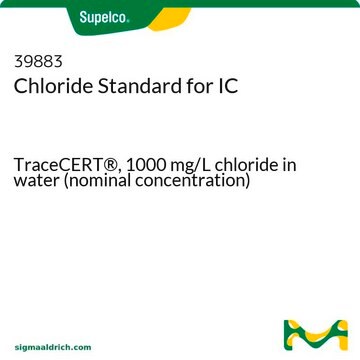1.19897
Chloride standard solution
traceable to SRM from NIST NaCl in H₂O 1000 mg/l Cl Certipur®
Sinónimos:
Chloride standard for aqueous matrices ready foruse
Iniciar sesiónpara Ver la Fijación de precios por contrato y de la organización
About This Item
UNSPSC Code:
41116107
NACRES:
NA.24
Productos recomendados
Quality Level
technique(s)
ion chromatography: suitable
density
0.998 g/cm3 at 20 °C
application(s)
environmental
food and beverages
format
single component solution
storage temp.
15-25°C
Categorías relacionadas
Application
- Chloride calibration standard for ion-selective electrodes: Chloride standard solutions are vital in calibrating ion-selective electrodes, ensuring precise and accurate measurements essential for environmental monitoring, clinical diagnostics, and industrial processes. The chloride ion reference solution ensures that all analyses meet high-quality standards necessary for reliable data collection and compliance with regulatory requirements. (Hanif et al., 2024).
- Pharmaceutical grade chloride solution for biochemistry assays: In pharmaceutical research, chloride standard solutions are used to maintain the integrity of biochemical assays. This standard is crucial in determining chloride content in drug formulations, essential for drug stability and effectiveness, thereby supporting pharmaceutical quality control processes. (Jantra et al., 2024).
- Chloride ion reference solution for analytical research: Chloride standards are extensively used in analytical laboratories as reference materials to validate the performance of analytical instruments. This application is fundamental to the development of new analytical techniques, ensuring that research outputs are based on validated and reliable data. (Hanif et al., 2024).
- Analytical chloride standard for research: Chloride standards are crucial in experiments involving the study of chloride′s chemical behavior and interactions with other substances. This is particularly important in the development of new materials and chemicals that may interact with chloride ions, thereby enhancing scientific understanding and innovation in material science. (Jantra et al., 2024).
- High-purity chloride standard for pharmaceutical analysis: The use of high-purity chloride standards in pharmaceutical analysis ensures that all measurements of chloride in pharmaceutical products are precise, meeting regulatory standards. This supports the quality control processes of pharmaceutical manufacturing, where exact composition is crucial for product efficacy and safety. (Hanif et al., 2024).
Analysis Note
Concentration β (Cl⁻): 990 - 1010 mg/l
Determination method: Argentometric titration.
The content of this solution was determined with silver nitrate standard solution (article number 1.09081) standardized against volumetric standard sodium chloride (article number 1.02406). The expanded measurement uncertainty is ± 0.4 % (k=2 coverage factor for 95% coverage probability). The certified value is traceable to primary standard NIST SRM 999b (NIST: National Institute of Standards and Technology, USA) by means of volumetric standard sodium chloride, measured in the accredited calibration laboratory of Merck KGaA, Darmstadt, Germany in accordance to DIN EN ISO/IEC 17025.
Determination method: Argentometric titration.
The content of this solution was determined with silver nitrate standard solution (article number 1.09081) standardized against volumetric standard sodium chloride (article number 1.02406). The expanded measurement uncertainty is ± 0.4 % (k=2 coverage factor for 95% coverage probability). The certified value is traceable to primary standard NIST SRM 999b (NIST: National Institute of Standards and Technology, USA) by means of volumetric standard sodium chloride, measured in the accredited calibration laboratory of Merck KGaA, Darmstadt, Germany in accordance to DIN EN ISO/IEC 17025.
Legal Information
CERTIPUR is a registered trademark of Merck KGaA, Darmstadt, Germany
Storage Class
12 - Non Combustible Liquids
wgk_germany
nwg
Certificados de análisis (COA)
Busque Certificados de análisis (COA) introduciendo el número de lote del producto. Los números de lote se encuentran en la etiqueta del producto después de las palabras «Lot» o «Batch»
¿Ya tiene este producto?
Encuentre la documentación para los productos que ha comprado recientemente en la Biblioteca de documentos.
Los clientes también vieron
Nuestro equipo de científicos tiene experiencia en todas las áreas de investigación: Ciencias de la vida, Ciencia de los materiales, Síntesis química, Cromatografía, Analítica y muchas otras.
Póngase en contacto con el Servicio técnico





